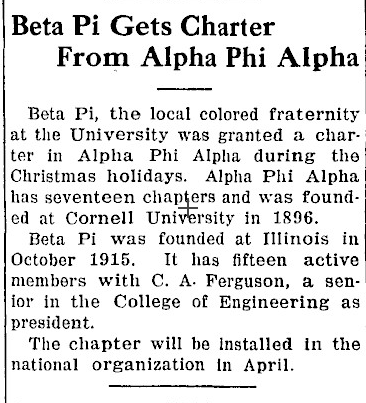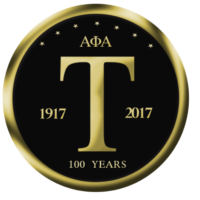TAU HISTORY
THE ROOTS OF TAU CHAPTER
The roots of TAU Chapter lie in the foundation of the Beta Pi Fraternity in 1915, which regularly met at 601 E. White Street, on the campus of the University of Illinois-Urbana, Champaign. The Ninth Convention of Alpha Phi Alpha Fraternity, Incorporated elected to induct the members of Beta Phi into the Fraternity as its eighteenth undergraduate chapter. TAU Chapter was installed on March 23, 1917 by Brother George P. Hinton of Pi Chapter (Case Western Reserve, Cleveland, Ohio).

CHARTER MEMBERS

IN THE BEGINNING...
In 1915, a fraternity was organized at the University of Illinois named Beta Pi on the campus of the University of Illinois at Urbana-Champaign. Bro. Theodore Roane served as President, and Bro. H.K. Barnett as secretary. These two brothers were instrumental in securing resources and made the arrangements for the first chapter house.
In March of 1916, the fraternity was recognized by University Council for maintaining adequate academic progress—that is, earning at least a 70% grade average. The following month, April 21-23, 1916, the fraternity hosted “the first affair ever given by a fraternity composed of members of the race at [the University of Illinois]” Indeed, the event was widely attended, with guests from the local Champaign-Urbana community, Chicago, Springfield, and St. Louis. Of those in attendance, included, Mrs. Ida B. Wells-Barnett, mother of Beta Pi member H.K. Barnett, as she served as a chaperon for the party.
Other guests included: Miss Beth Moseley and Melba Perry, who accompanied Mrs. Barnett from Chicago; Odessa Wright, Hazel Alexandra, Hatti Leonard, Edna Richardson, and a host of others. “The visitors left for their home after four days of royal good time. They reported that the young men left nothing undone to make their stay most pleasant.”
Later that year in October, Beta Pi held an Open House for prospective members as reported in The Daily Illini (1916) “Beta Pi starts colored frat competition. ”
The reporter continued, “While the fraternity is only local, the members make no secret of that Illinois will soon have [a] chapter of Alpha Phi Alpha” In an interview, H.K. Barnett, a charter member of Beta Pi, promises a prosperous year. “You see, it is not a question with us taking everybody. We have a wealth of material to choose from. We have pledge[d] [only] four of the twelve [guys interested],” Barnett said.
Those four members included: Bro’s Ralph Maizell, H. French, William J. Powell, and Benjamin C. Duster.”
Six months later, on Sunday, October 13, 1916, Beta Pi celebrated a new fraternity house after successfully passing inspection from university officials. The two-story, ten-bedroom house was located at 201 South Wright Street, and adorned with “first class furniture” said F.L. Barnett and Phil Jones, representatives from the Chicago Defender who were in attendance.
While the brothers of Beta Pi were certainly known for their extravagant parties, they were equally celebrated for their service. For instance, Beta Pi was cited for its efforts during the Christmas holiday in 1916, as members of the fraternity prepared and distributed food baskets to families in need.
Prior to the 9th General Convention in 1916 Richmond, Virginia on the campus of Virginia Union University, the brothers of Beta Pi submitted a petition to be chartered as a chapter of Alpha Phi Alpha. At the convention, several applications for new chapters were discussed and ultimately denied. The only application that was approved by the General Body was the petition from Beta Pi Fraternity at the University of Illinois.
On the evening of Friday, March 23, 1917 the fraternity was installed as Tau Chapter of Alpha Phi Alpha.
The ceremony was led by Bro. George P. Hinton, the General Secretary, and an initiate of Pi Chapter (Case Western Reserve University); and took place at the local chapter house. Quickly following the initiation, Tau Chapter hosted a banquet, also in the fraternity house.
As Tau was in its infancy stage, so too was a larger war in the United States. On April 6, 1917, Congress declared a state of war between Germany and the U.S. Quickly following, a group of brothers in Washington, “were thinking and planning of obtaining places of leadership in the military service for the race” (Wesley, 2008, p.116).
Beta Chapter house (Howard University) was the source of the movement, leading to the establishment of an Officers’ Training Camp. While the government was quick to overlook the camp of Black officers, Howard, along with Beta Chapter, its faculty, and the entire study body worked to convince government officials “of the advisability of training black officers to become troops.”
The result was positive, with the establishment a Training Camp at Fort Des Moines, Iowa. The camp started June 15 with 58 brothers of Alpha in the ranks—a larger representation than other club or fraternity. Later that year in October, 32 commissions were granted to Alpha Phi Alpha men, four of which were captaincies. Several Tau Chapter brothers were among those who were commissioned, including: W.J. Powell and George A. Ferguson, as First Lieutenant and; R.E. Mizell and C.S. Hardy, as Second Lieutenants. Several brothers from Theta Chapter were also at the training camp and were commissioned. In November of 1917, General President William A. Pollard “issued a message…that paid tribute the brothers of Beta who aided in bringing about the Training Camp and the movement to commission black officers” (Wesley, p. 119). Indeed, through their effort, over 600 Black men received commissions.
As one might imagine, Tau Chapter took an enormous blow as a result of the war, with some of its members leaving for training camp. The Daily Illini (1917) reports, “Beta Pi and Kappa Alpha Psi, the two negro fraternities, have done no pledging this year and are living together in the Beta Pi house.”
In a letter to the Sphinx magazine in 1919, Bro. Richard Harewood notes, “We now have seven men in school, but we are working hard and look forward to a successful year next fall. Of course you brothers know that this chapter was established during war times and that it was by our hardest effort that we were able to retain our activity during this period. We also believe in quality rather than quantity. Out of the men that have returned to school last quarter we have not found any promising material. Our young men are fast attaining that quality and distinction that is peculiar of A.P.A. We have also inherited the spirit ‘A.P.A. not for college but for life.’ We are fast rounding our alumni and delinquent members into line and hope to be able to boast of a 100 percent average.
After the conclusion of the war, Tau became a driving force on the campus of the University of Illinois with an influence that lasts to this very day. Tau has been a highly decorated chapter within the fraternity and in the Urbana/Champaign community. Tau has hosted several state conferences/conventions, assisted with Regional and General conventions, along with maintaining the directives of not only developing leaders, but being servants to all.
- Attended Wendell Phillips H.S. in Chicago, IL
- Entered the University of Feb. 26, 1913
- Studied in the college of Liberal Arts and Sciences
- Entered the University Oct. 2, 1916
- Studied in the College of Liberal Arts and Sciences
- His son Benjamin Jr. attended UIUC and DePaul Law School.
- Two of his other sons Charles Duster and Donald Duster also attended UIUC.

© 2023 Alpha Phi Alpha Fraternity, Inc. TAU Chapter.
Website by WEBKUBE